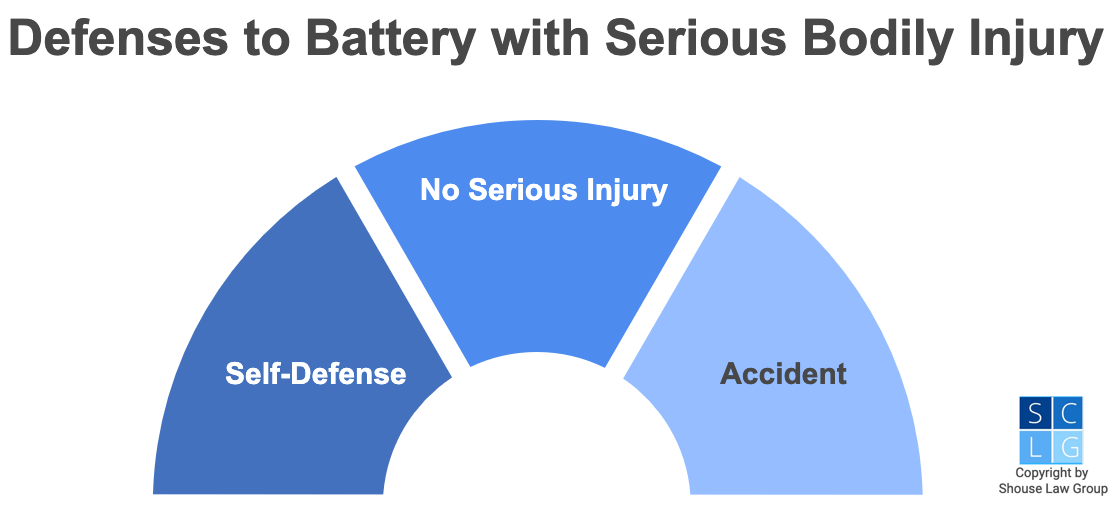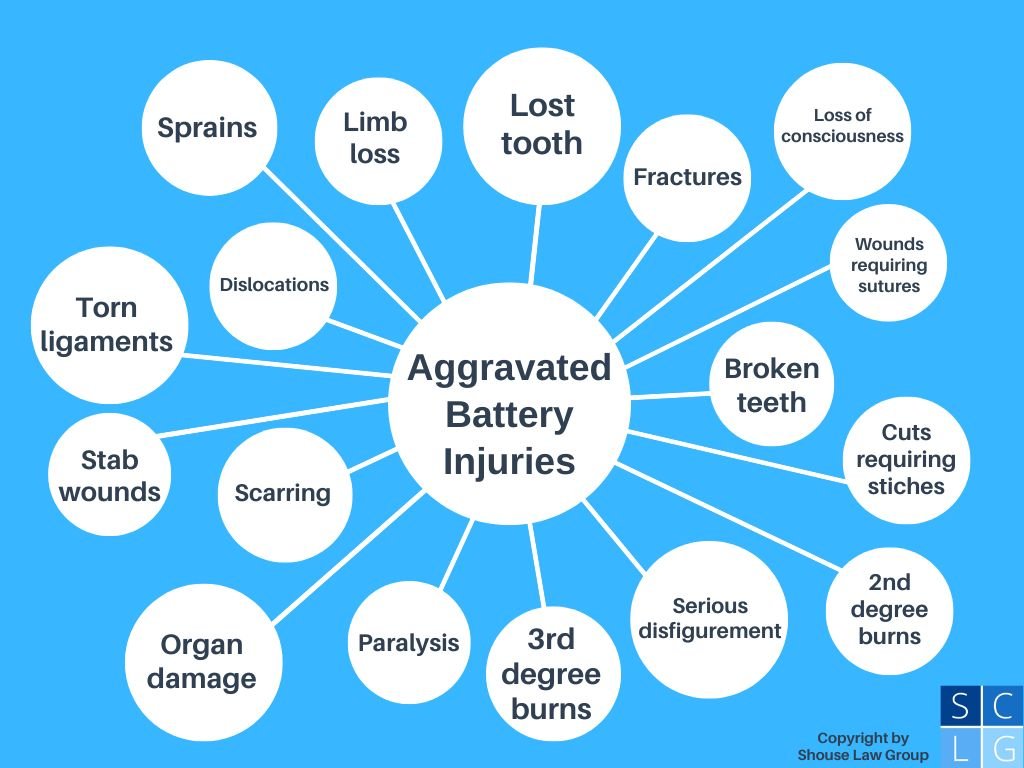California Penal Code § 243 d PC prohibits battery causing serious bodily injury, also called “aggravated battery.” Depending on the case, battery causing serious bodily injury can be a misdemeanor carrying up to one year in jail or a felony carrying up to four years in jail.
The term “serious bodily injury” means any serious impairment of someone’s physical condition regardless of whether medical treatment is necessary. California courts have found the following injuries to be “serious bodily injury:”
- a lost tooth up to its root,
- a loss of consciousness,
- a cut under the eye requiring eight stitches,
- a broken tooth, wounds on eyebrow, and lips requiring sutures, and
- bone fractures, broken bones, or serious disfigurement.

In this article, our California criminal defense attorneys address the following in this article re. aggravated battery:
1. Elements of 243(d) PC
To convict you of aggravated battery in violation of 243(d) PC, prosecutors must prove beyond a reasonable doubt the following three elements of California Criminal Jury Instruction “CALCRIM” 925:
- you willfully and unlawfully touched the alleged victim in a harmful or offensive manner,
- the alleged victim suffered serious bodily injury as a result of the force or touching, and
- you did not act in lawful self-defense or defense of others.1
You touch someone “willfully” when you do it on purpose.2 A “touch” is any time you make physical contact with another party, including through clothing.3
Example: Overcome with anger, Melissa shoves Ben lightly. This causes Ben to slip and fall, breaking his ankle. Melissa did not touch Ben forcefully—but because she touched him at all, and a serious injury resulted, she may be guilty of battery causing serious injury.
Note that offensive touching can be done indirectly by causing an object – or someone else – to touch the alleged victim.4
The following bubble graph shows examples of serious bodily injuries that can elevate a simple battery to an aggravated battery.

2. Defenses
Here at Shouse Law Group, we have represented literally thousands of people charged with violent offenses in California, including aggravated battery causing serious bodily injury. In our experience, the following three defenses have proven very effective with prosecutors, judges, and juries at getting 243(d) PC charges reduced or dismissed.
1) You Acted in Self-Defense
Self-defense works as a legal defense against a battery charge when all of the following are true:
- you reasonably believed that you (or another person) were in imminent danger of suffering bodily harm,
- you reasonably believed that the immediate use of force was necessary to defend against that danger, and
- you used no more force than was reasonably necessary to defend against that danger.5
To prove this defense, we amass such evidence as video surveillance footage and eyewitness accounts to show that your actions were justifiable under the circumstances.
2) There Were No Serious Injuries
243d PC charges apply only if you commit a battery and cause the victim to suffer a serious injury. A defense, then, is for you to say that while you may have committed a battery, the alleged victim did not suffer a serious injury.
To prove this defense, we rely on medical expert testimony to show that any injury the alleged victim sustained does not meet the definition of “serious.”
3) It Was an Accident
You cannot be convicted of aggravated battery causing serious bodily injury if you did not touch the victim willfully – that is, if the entire incident was an accident. So if you accidentally shoved someone in a crowd, or tripped and fell into them, you should not be found guilty of this crime.6
To show that what happened was an accident, we would consult with an “accident reconstruction expert.” This expert may be able to show that what transpired could not possibly have been intentional.

California’s Penal Code 243d PC prohibits aggravated battery causing serious bodily injury.
3. Sentencing
A violation of 243d PC is a wobbler, meaning that a prosecutor can charge as either a misdemeanor or a felony depending on the facts of the case and your criminal history.
Misdemeanor aggravated battery causing serious bodily injury is punishable by:
- up to 1 year in jail and/or
- a maximum fine of $1,000.7
Felony aggravated battery causing serious bodily injury is punishable by:
- 2, 3, or 4 years in jail and/or
- a maximum fine of $10,000.8
Note that your sentence will increase by three to six years if the victim’s injuries qualify as “great bodily injuries” per 12022.7 PC, which are worse than “serious bodily injuries.”9
4. Related Offenses
- Simple battery (242 PC) – willful and unlawful use of force or violence on another person.
- Simple assault (240 PC) – unlawful attempt, along with the present ability, to cause a violent injury to another person.
- Mayhem (203 PC) – unlawfully or maliciously attacking another person in a way that causes disfigurement or disability.
- Assault with a deadly weapon (245(a)(1) PC) – attacking or attempting to attack another person with a deadly weapon.
- Domestic battery (243(e)(1) PC) – using force or violence against your cohabitant, co-parent, or current or former significant other.
- Sexual battery (243.4 PC) – touching another person’s intimate parts without their consent for the purpose of sexual gratification, arousal, or abuse.

Aggravated battery can be a felony or misdemeanor.
Additional Reading
For more in-depth information, refer to these scholarly articles:
- Aggravated Battery – The Fist or Teeth as a Dangerous Weapon – Louisiana Law Review.
- Territorial Aggression – Expanding California’s Penal Code Regarding Assault and Battery of Code Enforcement Officers – McGeorge Law Review.
- What’s Reasonable: Self-Defense and Mistake in Criminal and Tort Law – Lewis & Clark Law Review.
- Defending Battered Women’s Self-Defense Claims – Oregon Law Review.
- Assault and Battery – Injury Sustained in Prize Fight – Consent as a Bar to Civil Liability – Vanderbilt Law Review.
Legal References:
- California Penal Code 243d PC (“When a battery is committed against any person and serious bodily injury is inflicted on the person, the battery is punishable by imprisonment in a county jail not exceeding one year or imprisonment pursuant to subdivision (h) of Section 1170 for two, three, or four years.”). People v. Martinez (1970) 3 Cal.App.3d 886. See also In re Cabrera (2023) . Judicial Council of California Criminal Jury Instructions (2024 edition) CALCRIM No. 925 – Battery Causing Serious Bodily Injury (Pen. Code, §§ 242, 243(d))
To prove that the defendant is guilty of this charge, the People must prove that:
1. The defendant willfully [and unlawfully] touched in a harmful or offensive manner;
[AND]
2. suffered serious bodily injury as a result of the force used(;/.)
[AND
3. The defendant did not act (in self-defense/ [or] in defense of someone else/ [or] while reasonably disciplining a child).]See also People v. Burroughs (1984) 35 Cal.3d 824; People v. Blakeley (2000) 23 Cal.4th 82; and, People v. Taylor (2004) 118 Cal.App.4th 11. People v. Wade (2012) 204 Cal.App.4th 1142. Whether a given injury is actually a serious bodily injury is always a question for the jury or judge to decide in each individual case. A judge or jury decides the issue by examining all of the facts within the case. People v. Belton (2008) 168 Cal.App.4th 432. People v. Wade (2012) 204 Cal.App.4th 1142. People v. Hood (2014) 223 Cal.App.4th 1356. People v. Hale (1999) 75 Cal.App.4th 94. - CALCRIM No. 925. See also People v. Lara (1996) 44 Cal.App.4th 102.
- CALCRIM No. 925.
- See same.
- CALCRIM 3470 – Right to Self-Defense or Defense of Others.
- Our Pasadena criminal defense lawyers have conducted dozens of jury trials and juvenile adjudication hearings, defending everything from assault & battery (including aggravated battery) to California elder abuse cases to sexual battery to DUI and domestic violence.
- California Penal Code 243d PC. See also California Penal Code 672 PC.
- California Penal Code 243d PC. See also California Penal Code 1170h PC. See also United States v. Perez (9th Cir. Cal. 2019), 932 F.3d 782; People v. Johnson (Cal. App. 5th Dist. 2016), 244 Cal. App. 4th 384.
- “Great bodily injury” is distinct from “serious bodily injury. “Great bodily injury” is defined as a significant or substantial physical injury (People v. Taylor (2004) 118 Cal.App.4th 11). California Penal Code 12022.7 PC.
